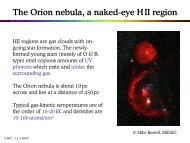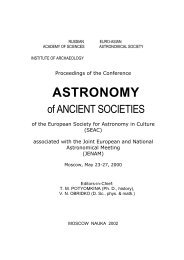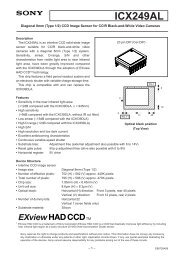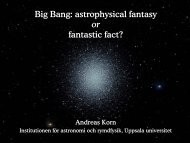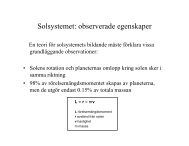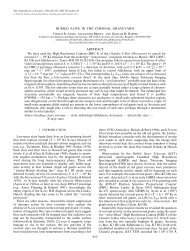Opacity
Opacity
Opacity
Create successful ePaper yourself
Turn your PDF publications into a flip-book with our unique Google optimized e-Paper software.
Q: What is the difference between κ ν and κ λ ?One may form a mean of κ over frequency or wavelength,e.g. a harmonic mean with dB ν (T)/dT as weighting function:1/κ R =∫ 1/κν dBν(T)/dT dv∫ dBν (T)/dT dvFor optically thick gas (like in stellar interiors) one mayfind for the total radiative flux∝1/κ R dT/dsObviously, this is analogous to the Equation of Heat Transfer with 1/κ Rplaying a role corresponding to conductivity. κ R , and similar means, areoften called ”opacity”. Sometimes the term is also used for κ ν .
The Einstein coefficients (Einstein 1917)ulProbability that atom will emit a quantumhν in time dt and solid angle dω is A uldt dωContribution of spontaneous emission coeff.j νis j νρ = N uA ulhν where N uis the number of atomsexcited to level u per unit volume.I νProbability for stimulated emission per atom giving quantum hνin time dt and solid angle dω is B ulI νdt dωI νulProbability for absorption by atom of quantum hνin time dt and solid angle dω is B luI νdt dωEnergy of radiation absorbed per unit pathlength and frequency, from beam withintensity I ν:κ ν ρ I ν= N lB luI νhν − N lB ulI νhν
The Einstein coefficients (Einstein 1917)ulProbability that atom will emit a quantumhν in time dt and solid angle dω is A uldt dωContribution of spontaneous emission coeff.j νis j νρ = N uA ulhν where N uis the number of atomsexcited to level u per unit volume.I νProbability for stimulated emission per atom giving quantum hνin time dt and solid angle dω is B ulI νdt dωI νulProbability for absorption by atom of quantum hνin time dt and solid angle dω is B luI νdt dωEnergy of radiation absorbed per unit pathlength and frequency, from beam withintensity I ν:κ ν ρ II ν ν = N lB lu II ν ν hν − N lB ul II ν ν hν
Now, assume Thermodynamical Equilibrium!N u /N l =g u /g l exp(-hν/kT)Boltzmann distribution, g u and g l statistical weightsAlso, number of downward transitions = number of upward transitions per time unit.Collision transitions up and down cancel in TE => N uA ul+ N uB ulI ν= N lB luI νSolve for I νand use the Boltzmann distribtution:Ι ν=A ul(g l /g u ) B luexp (hν/kT) - B ulcf Planck’s law:Ι ν=2hν 3 1c 2 exp (hν/kT) - 1This obviously suggests{ AulB ul= (g l /g u ) B lu= 2hν 3 /c 2 B ulNote: Planck’s law can actually be proven this way, if oneuses the low energy limit (Rayleigh-Jean´s law),see Gray, page 115
Now, assume Thermodynamical Equilibrium!N u /N l =g u /g l exp(-hν/kT)Boltzmann distribution, g u and g l statistical weightsAlso, number of downward transitions = number of upward transitions per time unit.Collision transitions up and down cancel in TE => N uA ul+ N uB ulI ν= N lB luI νSolve for I νand use the Boltzmann distribtution:Ι ν=A ul(g l /g u ) B luexp (hν/kT) - B ulcf Planck’s law:Ι ν=2hν 3 1c 2 exp (hν/kT) - 1This obviously suggests{ AulB ul= (g l /g u ) B lu= 2hν 3 /c 2 B ulNote: Planck’s law can actually be proven this way, if oneuses the low energy limit (Rayleigh-Jean´s law),see Gray, page 115BUT, these are only atomicquantities -- independent ofassumption of TE. Thus, therelations are generally valid!
Microscopic absorption mechanisms• bound-free (bf) absorption -- fotoionization• free-free (ff) abosorption -- cf Brehmsstrahlung• bound-bound (bb) absorption - line absorptionscattering
The determination of cross sections(like B ij or B ik )• Many measurements exit, not the least of A ji (life times). SeeVald data base (Piskunov et al.). Difficult for excited states.Often missing for photo-ionization.• Calculations:a) Classical electrodynamics calc. Gives dimensionally correctexpressions, but may be orders of magnitude wrong, not theleast for weaker transitionsb) Semiclassical (atom QM, electromagnetic field Classical).Problem to determine wave function describing many-electronsystems. Hartree-Fock self-consistent field method (sum overelectron pairs spherical average for each electron.Wave function written as Slater determinant. In the end theline strengthS = a20 e 2 σ 2 S(M)S(L), σ 2 ~ {P n’l’ P nl r dr} 2c) Full QMRadial partStrenghs of multiplet and of line in multiplet
From micro to macro:• Typical atomic dimensions: Bohr radius a 0 = 5 10 -9 cm.• Typical atomic cross section: π a 02= 8 10 -17 cm 2 .• Typical max density in stellar atmosphere gas:N a = 10 17 atoms/cm 3• Typical distance between atoms: 1/ 3 a >10 -6 cm, i.e. much morethan atomic dimension• Typical max cross section area of one cm 3 : 8 10 -17 x 10 17 =>=> stellar atmosphere matter may be quite opaque at depth.However, most atoms are not excited so much if not ionized =>only opaque at very short wavelengths. E.g. for hydrogen and λ >912 Å the Boltzmann factor exp(-hν/kT) = 10 -10.3θ with θ=5040/Tbrings the cross section down very considerably.
• This suggests that we can just sum up all individual contributionswithout taking possible collective phenomena into account:κ ν ρ = N l B lu hν• We may as well include the stimulated emission into this (since italso scales with I ν ), and get κ ν l ρ = N l B lu hν (1-e -hν/kT )• We can instead take the cross section for absorption of atom atlevel l:α l = B lu hνand thus getκ ν l ρ =N g l exp(-χ l /kΤ)/Q α l (1-e -hν/kT ) where Q = g i exp(-χ i /kΤ)Here, we have assumed the Boltzmann distribution to be valid(LTE).
Important example: Hydrogen atomsE (eV)13.6n = 10.2 n = 2Lyman continuum λ < 912 ÅLy α, λ = 1216 ⊕0.0 n = 1
Important example: Hydrogen atomsE (eV)13.6n = 10.2 n = 2Balmer continuum λ < 3646 ÅBalmer α, λ = 6563 ⊕0.0 n = 1
Important example: Hydrogen atomsE (eV)13.610.2n = n = 3Paschen continuum λ < 8207 ÅPaschen α, λ = 18756 ⊕0.0 n = 1
Rydberg’s formula1/λ = R Z 2 (1/n 2 - 1/m 2 )Z = atomic numberm > nR = R {1-m e /(m e +M)}R = 1.097 373 105 cm -1M = atomic mass, m e = electron massJohannes Rydberg1854-1919E n = - R h c Z 2 /n 2Niels Bohr 1885-1962
Absorption by neutral hydrogen (H I)bf absorptionα n = 1.044 10 -26 g n ’ λ 3 /n 5 (λ in Å, result in cm 2 )Kramers (1923) Cramers!”Gaunt” factor correcting classical result to QM g n ’ ≈ 1Q: Physical interpretation of λ 3 dependence?See Gray, Fig. 8.2! Note at ionization limits: ν = hRc/n 2⇒ α n at ionization limit ~ n.Also note that g n = 2n 2 so that we getκ(HI-bf) = 1.044 10 -26 λ/n} 3 g n ’ 10 −θχn 0Higher levels may be approximated by integral, see Gray p 145 ff
HI, ff absorptionClassicallydα ff = (2/ 3π) h 2 e 2 R/(m 3 ν 3 v) dvv electron speed. Q: Why v in denominator?Integrate over Maxwell distribution of electrons!=>α ff = const λ 3 / per H ion and electronQM: Correct again in Gaunt factor g ff and multiply withN ion and N e and divide by N 0 (= # H atoms) to get abs. coeff per Hatom:κ(Hff) = const λ 3 g ff T 10 −θΙHere, I is the ionization energy, 13.6 eV.Q: Explain the linear T dependence!
The H - absorptionA bound state, dissociation energy 0.754 eV 16 450 Å.Wildt (1939): H - dominant absorber in solaratmosphere.How much H - is there?Saha:N(H I)N(H-) = 1.34 T5/2 10 -0.754 θ /P eHow much H- do you find in thesolar atmosphere?One finds about 2 H - per 10 8 H I.Q: Why is it still important?
The H - absorption, cont.We get thenκ(H - bf ) = 4.158 10-10 α bf (H - ) P e θ 5/2 10 0.752 θ (cm 2 per H atom)There is also free-free H - ,again with a λ 3 behaviour.α ff(H - ) in cm 2 per ion anddyne electron pressure
Other hydrogen contributors• H 2+(near UV, requires H I and protons)• H 2-(ff in IR, cool stars)• H+H (Quasi molecule, UV).• Other negative ions• He - (ff in IR for cool stars)• C - , N - , C 2- , … (ff in IR, cool stars, note C stars)• Helium• Important for hot stars, but more He II than He I. Q: Why?• He I first series limit at 504 Å (ion. energy 24.6 eV)• Two systems, singlet and triplet. Edges close to H.• He II similar to H I but shifted to λ/4 (cf Rydberg’s formula),227 Å Ly series limit.
Metals matter!• C, Si, Al, Mg, Fe, … bf, mostly in UV• Complicated to calculate<strong>Opacity</strong> project, quantum-defect method.Note resonances.bf absorption also included.Mike Seaton
Scattering• Scattering vs electrons.Thomson scattering: α e = 6.6510 -25 cm 2 /electron.Independent of frequency! Averaged over angle, phasefunction for dipole scattering: (1+cos 2 θ)/2.Q: cf Comton scattering!N e from Saha’s law. Note different electroncontributors for different temperatures. Which?For which stars is electron scattering important?• Rayleigh scattering vs H I, He I and H 2 .Note λ -4 dependence! For which stars are these important?
The overall picture• Se plots distributed at lecture!



